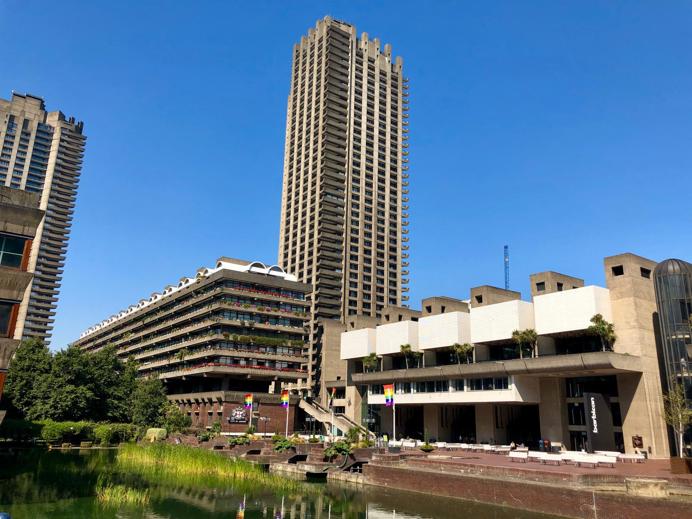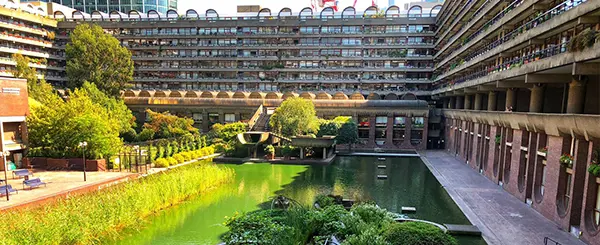I never thought the Barbican Estate and Marmite had anything in common: you probably either love them or you hate them? Well, maybe not. This year (July) marks half a century since residents first moved into the Barbican Estate and with each decade, love for the grey concrete mass on the north edge of the City of London seems to grow and grow. Its dominance on the skyline has diminished as other tall buildings appear but its distinct silhouette is still very recognisable.
The Barbican Estate

‘Barbican’ was the name of a street in the commercial area of the ward Cripplegate before Second World War bombing devastated the area in 1940. The Barbican Redevelopment Scheme took nearly thirty years to design and build and was completed in 1969. The development of the 40-acre bomb site involved the design of over 2000 flats, (including 3 of the tallest towers in London at the time), two schools and an arts centre. When erected, the concept and designs were controversial and even today it still sparks great debate. It was a pioneer of its time in terms of accommodation mix, size, design and quality - offering a place to live where almost all amenities were on site.
The Barbican Centre plans were approved in 1971 and included a 2000 seat concert hall, 1300 seat theatre, art gallery, library, Guildhall School of Music and Drama, cinemas, catering facilities, foyers and car parks. The scale and complexity of the project matched that of the earlier residential scheme taking over a decade to build and was described as “one of the modern wonders of the world” by the Queen in 1982 due to its scale, cohesion and ambition.
Clearly the Architects - Chamberlin, Powell and Bon – while creating a project that created conversation and divided opinion had done something right as in 2001 the Barbican was Grade II listed. But, why exactly has the development proved to have grown in popularity, appreciation and value over the last 50 years?
Nick Thompson, Senior Director and Head of Major Projects & Design at Lichfields noted that whilst the Barbican is a generally revered development nowadays and provides its residents with very convenient amenities as well as London with first class facilities its relative isolation, and inward-looking design with little ground level interaction with the outside world does not provide a good model for creating cohesive and interesting environments particularly for pedestrians moving through the area. It can be described in a city such as London as a unique development, reflecting design thinking at a particular point in time.
The quality of its design and build has been a major factor in its longevity. Though it was built by the City of London Corporation, it was never intended to be a traditional Council Estate aimed at low-income families paying subsidised rents. Rents at the Barbican in 1969 were premium – about £12 per week for a one-bedroom flat which allowed the Council not to skimp on build quality. Inside, the flats were well built too, with good quality finishes and a generous scale. Today’s London Plan provides minimum floorspace guidance of 538sqft (Chapter 3, Policy 3.5) for a one bedroom flat. This compares to a one-bedroom in the Barbican around 700sqft combined with good ceiling heights and natural light making them feel even bigger.
The community spirit held by its residents is another factor that makes the development special. It’s hard to imagine this being the case with it being so popular with visitors but from owner’s clubs and associations to a website run by residents, it’s clear that the Barbican community love where they live and wouldn’t choose to be anywhere else – often up and downsizing within the Barbican itself depending on their family circumstances.
Of course, a creation so polarising as the Barbican can’t be without its negatives. As many who have visited know, navigating around the estate can be tricky. Legibility including its relationship to the outside world is poor. Ray Bowden, who moved to the Estate with his wife in 1969, remembers being father to the first baby born in a Barbican flat – because the midwife failed to find them! In addition, while there are fantastic and unusual amenities provided on site (such as cinema and the cultural hub), others that you might consider more normal (such as gyms, cafes or restaurants) are nothing special at the Barbican. And considering the service charge is enough to make you choke on your “nothing special” meal – roughly £3000 per year for a one bedroom and £5000 for a two bedroom – the Barbican does not come with any exclusive resident perks such as gyms or bars. In additional to the service charge, residents have to pay towards the estate’s upkeep – about £4000 per year is normal.
However, if you are willing to accept this, it is this loyalty (and heavy financial commitment) that keeps the Barbican at its best. Many other examples of sixties council estates have failed arguably (amongst other factors) due to the lack and expense of upkeep. This goes back to the point of ownership and build quality – on the whole the City of London is not having to pay for the upkeep of the estate, the residents are.
So, what about the future? It appears that the Barbican is to continue to go from strength to strength, Blake Tower, formally the Barbican YMCA before being turned into luxury flats will officially become part of the estate in September. The Estate’s connectivity will also be boosted next year by the arrival of Crossrail at Farringdon. Finally, there are also plans to relocate the Museum of London (part of the Barbican) to a new home in Farringdon from London Wall and be replaced by a £300m concert hall. It is hoped that this project will reinvigorate the South-Western boundary of the Estate where it meets the rest of the City.
Asked if we might ever see the Barbican’s listing re-designated to Grade II* or even Grade I, Nick Bridgland, Heritage Director at Lichfields commented: “Brutalism has always provoked strong reactions but, 50 years on, it is possible to be bit more objective about its greatest buildings. The Barbican Estate was designed by one of the leading architectural practices of the day, is instantly recognisable and has stood the test of time. Other blocks of flats of this era such as Trellick and Balfron Towers by Ernö Goldfinger, the Byker Estate in Newcastle and Park Hill in Sheffield are listed at II* so greater formal recognition of the Barbican should not be ruled out”.
Until then, the Barbican will continue to create conversation and divide opinion but one thing’s for sure, after 50 years, it’s most certainly here to stay.
References:
Our building our architectureOur archive constructionHomes & Property
Life at the Barbican was joyous from the start




